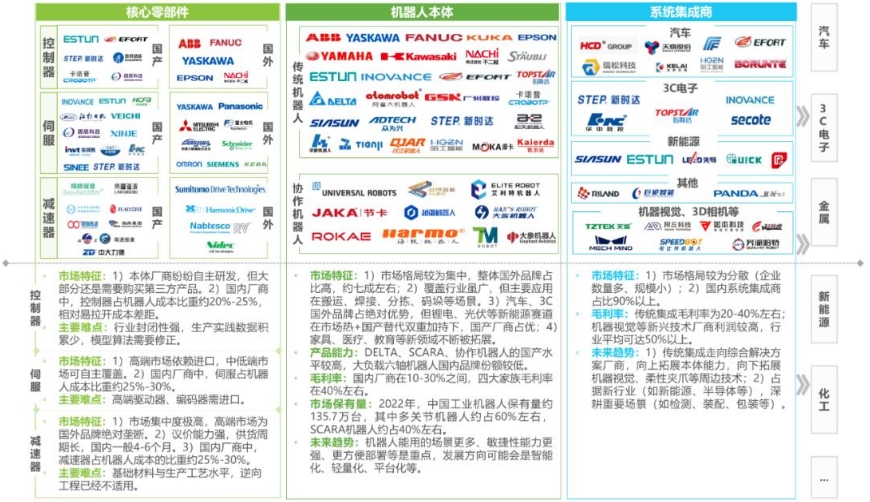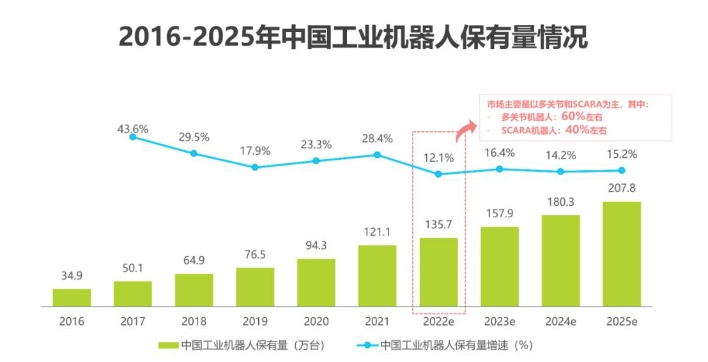Zhiliangce (Shanghai) Intelligent Technology Co., Ltd
Address:5th Floor, Building 11, No. 6055, Jinhai Road, Fengxian District, Shanghai
Contact:Manager Yang
Phone:17521576999

Industrial robot industry chain:
•Upstream-parts situation: 1) Reducer:The market concentration is extremely high, and the high-end market is monopolized by foreign brands, so manufacturers have strong bargaining power, accounting for about 25%-30% of the cost of robots. The overall supply cycle is long, generally 4-6 months in China.2) Servo:The high-end market relies on imports, and the low-end market can be covered independently. Among domestic manufacturers, servos account for about 25%-30% of the cost of robots.3) Controller:Ontology manufacturers have developed their own products, but most of them still need to purchase third-party products. The controller accounts for about 20%-25% of the cost of the robot.
Midstream - Ontology: 1) Holdings:In 2022, the number of industrial robots in China will be 1.357 million, mainly multi-joint robots and SCARA robots, accounting for about 60% and 40% respectively.2) Competitive Landscape:The market pattern is relatively concentrated, and the overall proportion of foreign brands is high, about 70%.3) The main ways of domestic manufacturers: to control the cost structure through the self-development of parts, to develop collaborative robots to increase product application scenarios, to expand new industries such as furniture, and to actively lay out the sea.
•Downstream-system integrators: 1) The market structure is relatively fragmented (large number of enterprises and small scale), of which domestic system integrators account for more than 90%. 2) Emerging integrated ecological partners such as machine vision and 3D cameras help the development of industrial robots' "eye/brain" and unlock more and more refined application scenarios. 3) Traditional system integrators are moving towards integrated solution manufacturers, that is, expanding ontology capabilities upwards and peripheral technologies such as machine vision and flexible grippers downward.

The future development trend of industrial robots:
•From the perspective of development direction: the development of industrial robots in the future is in the direction of improving the breadth and depth of application, in which motion control technology and control system technology promote product performance improvement, AI-related technologies promote intelligent improvement, and future industrial robots will develop in the direction of intelligence, refinement, flexibility and platform.
•From the perspective of industry development potential: automobile manufacturing, electronics and semiconductor manufacturing are still the main application industries; Lithium-ion/PV manufacturing is the main industry in the new market. In addition, the application potential of aerospace, home appliance manufacturing and other manufacturing industries is also relatively large.
Trend: Industrial robots tend to be platform-based
The platformization of industrial robots mainly refers to the standardization and generalization of the hardware and software of the ontology and its accessories, and the generalization of the core capabilities of application solutions
In the future, industrial robots will tend to be platform-based like PCs and mobile phones, which have the significance of efficient programming, rapid deployment, flexible application, and cost reduction. However, the main difficulties in the process of platformization need to be faced: 1) For the C-end driven and universal PC and mobile phone market, the platform helps to quickly occupy the market, so for the B-end driven industrial robot market with high industry application threshold, what can the current head players get from the platform? 2) In order to improve the professionalism of applications and reduce the threshold for application development and use, how to overcome the complexity and diversity of applications in the industrial field and how to establish standardized standards are the problems that need to be solved urgently.
Trend: Industrial robots help flexible production
The improvement of the functional diversity of industrial robots and the lowering of the threshold for interactive collaboration will promote the flexibility of industrial robot application scenarios, and then improve the flexibility of production lines
Industrial robots help flexible production is mainly focused on the production and manufacturing links and assembly links, the purpose of which is to meet the ability of the same production line to produce product categories, product styles, and product sizes diversification, and the core is to achieve production and marketing synergy."Position VS Functional Scene VS Interaction and Programming" is the key for industrial robots to help flexible production.The reasons are as follows: 1) variable location reduces repeated configuration and reduces the cost of production line changes; 2) The variable function scenario mainly refers to the realization of a function in position A, a function in position B, and function b, etc., which can improve the ability of flexible deployment of each link of the production line; 3) The threshold for interaction and programming is lowered, mainly to reduce the difficulty and cycle of development of functional scenarios.

Copyright © Zhiliangce (Shanghai) Intelligent Technology Co., Ltd All Rsssts Resved